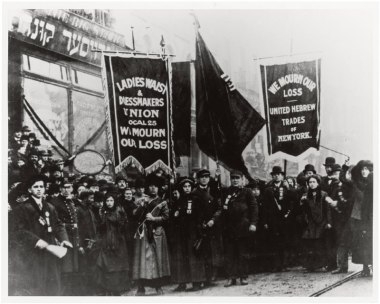What Happened to the “Working” in International Working Women’s Day?
 A post by staff member Daniel Willey
A post by staff member Daniel Willey
Wednesday, March 8th marked International Working Women’s Day and the Women’s Strike, or the Day Without Women. On that day, women were encouraged to not work or shop and wear red in solidarity as a way of protesting inequality and showing women’s economic impact.

Protest organizers Linda Sarsour, Tamika Mallory, and Carmen Perez arrested at New York protest on Wednesday
But, International Working Women’s Day has always been a day for striking. The first time this day was observed in 1908, women marched in New York City against poor working conditions and low wages. The observance of International Working Women’s Day (IWWD) spread quickly to other countries as a part of socialist movements and, eventually, as protests against WWI. In 1917, women, joined by female textile workers and eventually working men, gathered in the Russian capital to protest living and working conditions– a day which would spark the Russian revolution.
It is in honor of this history and this tradition that I write this blog.
There have been a lot of critiques of this year’s IWWD Women’s Strike. I’ve read about how only privileged women who can afford time off or have the job stability will participate. Prince George’s county schools closed on Wednesday because so many of their teachers requested the day off, leaving poor kids without school lunch and breakfast and working parents with nowhere to put their kids. Some just plain argue that the strike is a symbolic gesture and that it’s effectively useless as a strategy.
I’d like to make a different critique: when International Working Women’s Day becomes International Women’s Day, we lose the incredible power of the strike and deny the history paved by women in labor movements.
Okay, so let me take a step back and talk about labor and strikes for a second. In a capitalist economic system like the U.S, there are people who own the means of production (the tools that produce a product or perform a service such as factories, machinery, equipment, office space, etc) and there are people who sell their labor for a wage and work with this equipment or office space to produce the product or offer the service. For example, the owner of a manufacturing company (the capitalist) owns all the factories and resources necessary to make their product, but they must buy labor from workers in order to make this product. Of course, this system is a bit more complicated than that but that’s the basic gist.
So, if the capitalist wants to turn a profit, which most business owners do, they have to figure out how to make a product for cheaper than it can be sold. The ways of doing this are buying materials cheaply, paying for labor cheaply, or selling a product at a higher price. Nobody wants to buy an expensive product, so the capitalist generally relies on the first two ways. It is not in the interest of the capitalist to pay high wages or provide benefits to workers UNLESS…
UNLESS the workers refuse to work without them. This is where the strike draws its power. An essential part of what makes a union effective is that it is a collective tool: a worker refusing to work because of low wages gets fired and replaced; a workforce refusing to work shuts down the business and stops production and sales. It is the collectivity and the organization of a labor union which protects the individuals within and makes a strike an effective tool.
Herein lies my argument: labor simply isn’t organized the way it used to be and the individualistic approach we take to labor in general–and to this year’s women’s strike– diminishes the power we have as workers. The people who go on strike are traditionally the most at-risk, not the most privileged. When we say the women’s strike is only for privileged women, we actually mean that there is no collectivity or organization of women workers which will protect the most vulnerable of women. We mean that there is no general Women’s Union which will negotiate with employers on their behalf. We mean that we no longer view labor as a tool we can leverage but as something we owe to our employer for allowing us to live. Many women chose to go to work on Wednesday because they viewed their work as too important. Teachers, childcare providers, nurses, and others went to work regardless of whether they could strike. But that’s kind of the point of the strike– to say “You can’t survive without my labor so you had better treat me that way.”
I mean, I get it. The Women’s Center remained open because we wanted to be there for women and others on such an important day and we wanted to provide programming which would uplift and educate the community. We view the work we do as not only essential but also coming from our own sense of duty and morals, not necessarily a way to earn a living. But sometimes I feel like the incredible amount of personal and emotional resources my coworkers pour into the work they do get taken for granted and I wish they, and the Center, got more recognition for that.
I love the idea of a general Women’s Strike, but I think it must be organized on the principles of labor organizing and push against individualist approaches in order to be most effective. We must make demands for the benefit of black women, indigenous women, disabled women, undocumented women, mothers, and caregivers and all women must strike until these demands are met.

Women workers in New York strike to demand safer working conditions after a fire kills 146 Triangle Shirtwaist factory workers
Women have always been prominent in labor movements. Garment and textile workers, laundresses, and many other industrial manufacturing jobs were populated almost entirely by women. Following the famous Triangle Shirtwaist fire which killed nearly 150 women in 1911, 20,000 women went on strike to demand safer conditions. We can’t afford to lose the “working” in International Working Women’s Day because it ignores the impact of labor organizing by women on anything from maternity leave to the Russian revolution.
So what comes next? Learn about labor history. Join your student union. Support workers rights and current labor movements. Use your privilege to support and advocate for marginalized people in your workplace. Talk to people about your salary and encourage others to share theirs. And remember: never cross a picket line.
Posted: March 10, 2017, 11:46 AM
